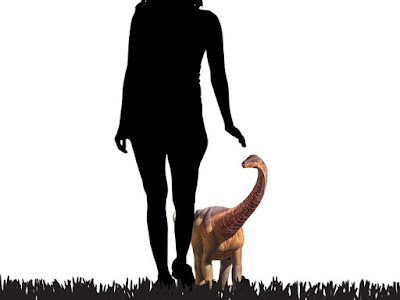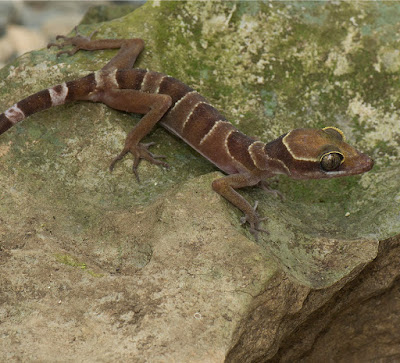[Most Recent Entries] [Calendar View]
Tuesday, April 26th, 2016
| Time | Event | ||
| 12:28a | [Paleontology • 2016] A Tiny Titanosaur, Rapetosaurus krausei, from the Cretaceous of Madagascar Abstract Sauropod dinosaurs exhibit the largest ontogenetic size range among terrestrial vertebrates, but a dearth of very young individuals has hindered understanding of the beginning of their growth trajectory. A new specimen of Rapetosaurus krausei sheds light on early life in the smallest stage of one of the largest dinosaurs. Bones record rapid growth rates and hatching lines, indicating that this individual weighed ~3.4 kilograms at hatching. Just several weeks later, when it likely succumbed to starvation in a drought-stressed ecosystem, it had reached a mass of ~40 kilograms and was ~35 centimeters tall at the hip. Unexpectedly, Rapetosaurus limb bones grew isometrically throughout their development. Cortical remodeling, limb isometry, and thin calcified hypertrophic metaphyseal cartilages indicate an active, precocial growth strategy. Tiny giant Titanosaurs were the largest land vertebrates to have evolved, but even they had to start small. Curry-Rogers et al. describe a baby Rapetosaurus only 35 cm at the hip at death. Histological and limb analysis suggest that this tiny giant had a much greater range of movement than it would have had as an adult. Furthermore, the work confirms hypotheses that these largest of dinosaurs were precocial, being able to move independently immediately after birth. This pattern differs from that seen in many contemporary dinosaur groups, such as theropods and ornithischians, for which increasing evidence suggests that parental care was important. K. Curry Rogers, M. Whitney, M. DEmic, B. Bagley. Precocity in A Tiny Titanosaur from the Cretaceous of Madagascar. Science. 2016; 352 (6284): 450 DOI: 10.1126/science.aaf1509 How to raise a dinosaur? Tiny fossil may tell us http://usat.ly/1WfMshm via @usatoday Tiny dinosaur skeleton reveals babies lived on their own from birth http://www.huffingtonpost.com/entry/dino Rapetosaurus krausei: Tiny titanosaurus was just a few weeks old, scientists say http://fw.to/AgAz4US | ||
| 10:11a | [Herpetology • 2016] Cyrtodactylus hidupselamanya & C. lenggongensis • Two New Bent-toed Geckos of the Cyrtodactylus pulchellus complex from Peninsular Malaysia and Multiple Instances of Convergent Adaptation to Limestone Forest Ecosystems
Abstract A new species of limestone cave-adapted gecko of the Cyrtodactylus pulchellus complex, Cyrtodactylus hidupselamanya sp. nov., is described from an isolated karst formation at Felda Chiku 7, Kelantan, Peninsular Malaysia. This formation is scheduled to be completely quarried for its mineral content. From what we know about the life history of C. hidupselamanya sp. nov., this will result in its extinction. A new limestone forest-adapted species, Cyrtodactylus lenggongensis sp. nov., from the Lenggong Valley, Perak was previously considered to be conspecific with C. bintangrendah but a re-evaluation of morphological, color pattern, molecular, and habitat preference indicates that it too is a unique lineage worthy of specific recognition. Fortunately C. lenggongensis sp. nov. is not facing extinction because its habitat is protected by the UNESCO Archaeological Heritage of the Lenggong Valley due to the archaeological significance of that region. Both new species can be distinguished from all other species of Cyrtodactylus based on molecular evidence from the mitochondrial gene ND2 and its flanking tRNAs as well as having unique combinations of morphological and color pattern characteristics. Using a time-calibrated BEAST analysis we inferred that the evolution of a limestone habitat preference and its apparently attendant morphological and color pattern adaptations evolved independently at least four times in the C. pulchellus complex between 26.1 and 0.78 mya. Keywords: Karst, new species, convergent evolution, conservation, extinction, Cyrtodactylus, Peninsular Malaysia, Thai-Malay Peninsula, Reptilia L. Lee Grismer, Perry L. Wood Jr, Shahrul Anuar, Marta S. Grismer, Evan S. H. Quah, Matthew L. Murdock, Mohd Abdul Muin, Hayden R. Davis, César Aguilar, Randy Klabacka, Anthony J. Cobos, Anchalee Aowphol and Jack W. Sites, Jr. 2016. Two New Bent-toed Geckos of the Cyrtodactylus pulchellus complex from Peninsular Malaysia and Multiple Instances of Convergent Adaptation to Limestone Forest Ecosystems. Zootaxa. 4105(5); DOI: 10.11646/zootaxa.4105.5.1 | ||
| 11:42p | [Invertebrate • 2016] Hantu gen. nov. • A New Genus of Ground and Litter-Dwelling Pholcine Spiders (Araneae, Pholcidae) from Sarawak Abstract Two small, ground and litter-dwelling pholcid species from northern Borneo are described as representatives of a new genus, Hantu gen. nov.: H. kapit gen. et sp. nov. and H. niah gen. et sp. nov. Previous cladistic analyses suggested a closer relationship with the genera Savarna Huber, 2005 and Khorata Huber, 2005 (mainland Southeast Asia) than with the geographically closer genus Aetana Huber, 2005 (Borneo and Philippines to Fiji). Since the two species do not share any of the synapomorphies of Khorata and Savarna while having several synapomorphies on their own (ventral apophysis on male palpal coxa; male palpal trochanter apophysis with small teeth or scales; spines on male femora 1; high density of vertical hairs on male femora; presence of scape on epigynum), they are here proposed as representing a new genus. Keywords. Borneo, Sarawak, endemism, taxonomy, Pholcidae. Class Arachnida Cuvier, 1812 Order Araneae Clerck, 1757 Family Pholcidae C.L. Koch, 1851 Hantu gen. nov. urn:lsid:zoobank.org:act:9DBCF7B6-8A03-4 Type species: Hantu kapit gen. et sp. nov. Diagnosis: Small, six-eyed, dark, ground and litter-dwelling pholcids with dark (usually black) sternum, with thoracic furrow extending over entire length of carapace, and without epiandrous spigots. Distinguished from putatively closest known relatives (Khorata, Savarna) by ventral apophysis on male palpal coxa (arrows in Figs 9, 19, 27), by scales or teeth on male palpal trochanter (Fig. 16), by spines on male femora 1 (~10–25 in single ventral row), by short vertical hairs in high density on male femora (in two dorsal rows), and by scape on female external genitalia (Figs 40–45); from Savarna also by presence of distal cheliceral apophyses (Figs 11, 28) and by male palpal trochanter apophysis not fused to femur (Figs 9, 27); from Khorata also by absence of sclerotized ledges laterally on male chelicerae (Figs 11, 28) and by absence of retrolateral process on male palpal femur (Figs 9, 27). Etymology: Named for the Hantu Rimba, deep-forest ghosts in traditional Malaysian mythology. Gender masculine. .............. Discussion Pholcid spiders are widely known for their long-legged representatives, some of which are synanthropic, but a large number of species in a range of genera are actually relatively short-legged ground and litterdwellers. About half of all currently recognized genera either include or consist entirely of such shortlegged species (e.g., Huber 2005a, 2005b, 2011, 2013, 2015; Huber et al. 2005). This suggests multiple convergent shifts among microhabitats; in fact, molecular data support the notion that such shifts have occurred repeatedly in various directions (Huber et al. 2010; Dimitrov et al. 2013; see also Huber & Dimitrov 2014). Ground and litter-dwelling pholcids share a similar habitus to a degree that allows reasonable predictions even for museum specimens without microhabitat information. They are small (body size ~1–3 mm), relatively short legged (leg 1 length < 30 mm), rather dark (brown), and have a globular or oval abdomen. This combination seems to be extremely rare in pholcids living in other microhabitats. The only apparent exception known to me are West and Central African representatives of the genus Anansus Huber, 2007 that were collected by canopy fogging (Huber 2007). In Southeast Asia, at least seven pholcid genera other than Hantu gen. nov. include ground and litterdwelling representatives: Aetana Huber, 2005; Belisana Thorell, 1898; Holocneminus Berland, 1942; Pholcus Walckenaer, 1805; Savarna Huber, 2005; Spermophora Hentz, 1841; and Wugigarra Huber, 2001. Bernhard A. Huber. 2016. A New Genus of Ground and Litter-Dwelling Pholcine Spiders from Sarawak (Araneae, Pholcidae). European Journal of Taxonomy. 186: 1–15. DOI: 10.5852/ejt.2016.186 |
| << Previous Day |
2016/04/26 [Calendar] |
Next Day >> |










